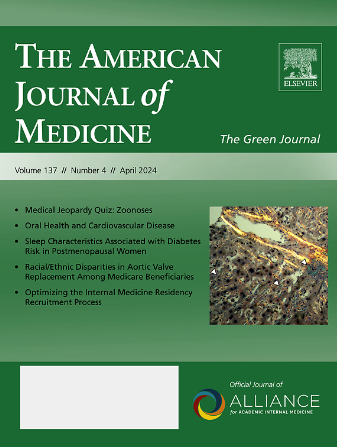年轻痴呆症患者的身体成分、血管健康、心肺功能、肺功能、肌肉结构和体育活动:病例对照研究
IF 2.5
3区 医学
Q1 MEDICINE, GENERAL & INTERNAL
引用次数: 0
摘要
背景:以前从未对年轻痴呆症患者的身体成分、血压、估计最大摄氧量(VO2max)、肺功能、体力活动、肌肉结构和内皮功能进行过研究。因此,该研究测量了年轻痴呆症患者的这些变量,并将其与年龄匹配的对照组进行了比较:方法:对估计的最大氧饱和度(通过阿斯特朗-韵律测试)、身体成分、血压、肺功能(通过肺活量测定)、肌肉结构(通过超声波)和内皮功能(通过血流介导的扩张)进行了评估。使用 ActiGraph 加速计对 7 天的体力活动进行了测量:我们招募了 33 名参与者(16 名年轻痴呆症患者,17 名对照组患者)。与对照组相比,年轻痴呆组的外侧肌筋膜长度较短、在七天内久坐的时间较长、完成的中等强度体力活动较少(配对比较分别为p=0.028,d=0.81;大效应;p=0.029,d=0.54;中效应;p=0.014,d=0.97;大效应)。配对比较表明,在 p2max(尽管有中等效应[d=0.66])、身高、体重、体重指数、血压、轻体力活动、肺功能、肌肉厚度、五点角或内皮功能方面没有差异:本研究强调了年轻痴呆症患者与对照组之间的差异,强调了多成分运动干预的必要性。未来的干预措施应以肌肉结构为目标,增加中等强度的体育锻炼,减少久坐,从而达到改善生活质量和促进功能独立的目的。本文章由计算机程序翻译,如有差异,请以英文原文为准。
Body Composition, Vascular Health, Cardiorespiratory Fitness, Lung Function, Muscle Architecture, and Physical Activity in People with Young Onset Dementia: A Case-Control Study
Background
Body composition, blood pressure, estimated maximal oxygen uptake (VO2max), lung function, physical activity, muscle architecture, and endothelial function had not previously been examined in people with young onset dementia. Therefore, the study measured these variables in a young onset dementia group, compared them to age-matched controls.
Methods
Estimated VO2max (via the Astrand-Rhyming test), body composition, blood pressure, lung function (via spirometry), muscle architecture (via ultrasonography), and endothelial function (via flow-mediated dilation) were assessed. Physical activity was measured using ActiGraph accelerometers for 7 days.
Results
We recruited 33 participants (16 young onset dementia, 17 controls). The young onset dementia group had shorter fascicle lengths of the vastus lateralis, were sedentary for longer over a 7-day period, and completed less moderate-vigorous physical activity than controls (P = .028, d = 0.81; large effect, P = .029, d = 0.54; moderate effect, and P = .014, d = 0.97; large effect, respectively for pairwise comparisons). Pairwise comparisons suggest no differences at the P < .05 level between young onset dementia and controls for estimated VO2max (despite a moderate effect size [d = 0.66]), height, body mass, BMI, blood pressure, light physical activity, lung function, muscle thickness, pennation angle, or endothelial function.
Conclusions
This study highlights differences between people with young onset dementia and controls, underscoring the need for multicomponent exercise interventions. Future interventions should target muscle architecture, increase moderate-vigorous physical activity, and reduce sedentariness, with the goal of improving quality of life and promoting functional independence.
求助全文
通过发布文献求助,成功后即可免费获取论文全文。
去求助
来源期刊

American Journal of Medicine
医学-医学:内科
CiteScore
6.30
自引率
3.40%
发文量
449
审稿时长
9 days
期刊介绍:
The American Journal of Medicine - "The Green Journal" - publishes original clinical research of interest to physicians in internal medicine, both in academia and community-based practice. AJM is the official journal of the Alliance for Academic Internal Medicine, a prestigious group comprising internal medicine department chairs at more than 125 medical schools across the U.S. Each issue carries useful reviews as well as seminal articles of immediate interest to the practicing physician, including peer-reviewed, original scientific studies that have direct clinical significance and position papers on health care issues, medical education, and public policy.
 求助内容:
求助内容: 应助结果提醒方式:
应助结果提醒方式:


